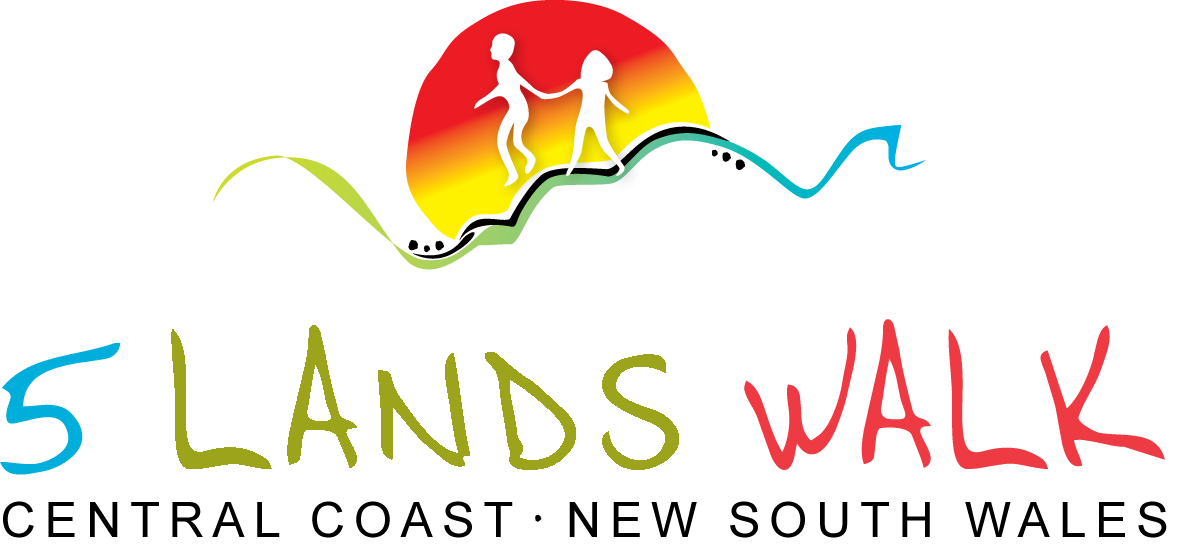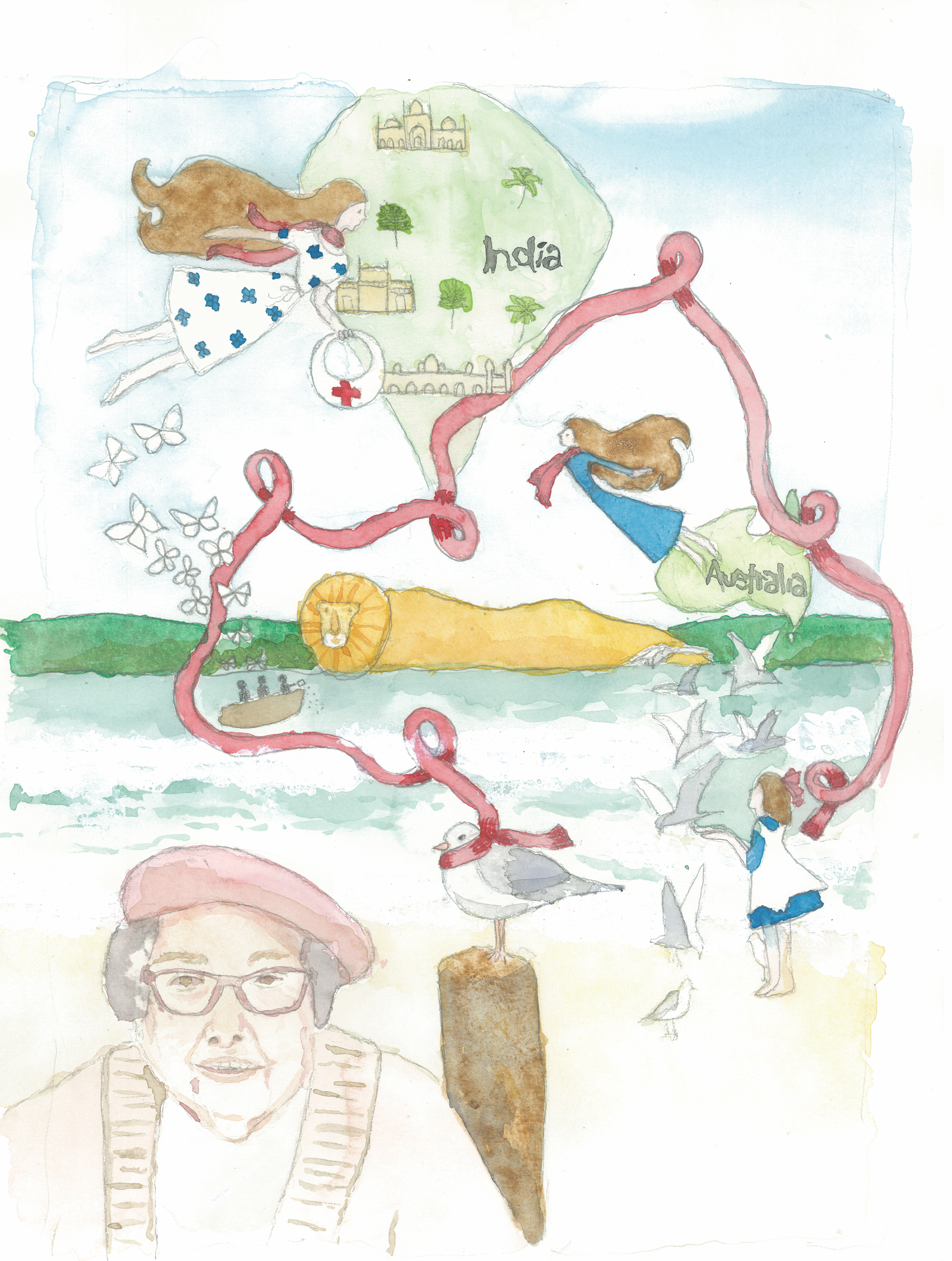
Amelie Pothof, 12 years old

When I was 24 years old I was living in Belmont and was working as Travelling Supervisor of Post Master General for Country Telephone Exchanges.
This position took me around rural NSW and I often visited Terrigal and the Entrance. In 1955 I was asked to move to Woy Woy, to be in
charge of the local telephone exchange. Soon after, I met my husband David. We were married in 1958 and Woy Woy became my permanent home.
The following year we welcomed our first child, Kathleen. She was a beautiful girl. She loved to visit Umina Beach, and enjoyed feeding the seagulls
and gazing out to Lion Island. David and I were blessed to have three more children, Therese, Michael and Frances, all of whom we are very proud.
Lion Island is a significant local landmark on the Central Coast. As its name suggests, the formation is in the shape of a proud lion in a
crouching position, protecting all who may sail, row or cruise into the magnificent Brisbane Waters. Lion Island is also home to many small
native creatures and birds, most notably the Baby Penguins.
Kathleen grew up to travel the world with her work, taking her to places all over the globe. Whenever she came home she
would always visit Umina Beach, taking in the view of Lion Island while feeding her beloved seagulls. This was one of her
favourite things to do. Kathleen often told me, "If anything happens to me Mum, please scatter my ashes near Lion Island.”
Sadly, Kathleen passed away after falling ill when working in India. She had devoted her life to human rights and working for the underprivileged.
We scattered her ashes in the waters near her Lion Island. Each year when we visit Umina Beach on her anniversary and birthday,
we admire the majestic Lion looking out to sea. Without fail, a single seagull always comes up close to us, never looking for food,
just to say hello and to remind us that Kathleen is never far away.
If our magnificent Lion could speak, what incredible stories he could tell!
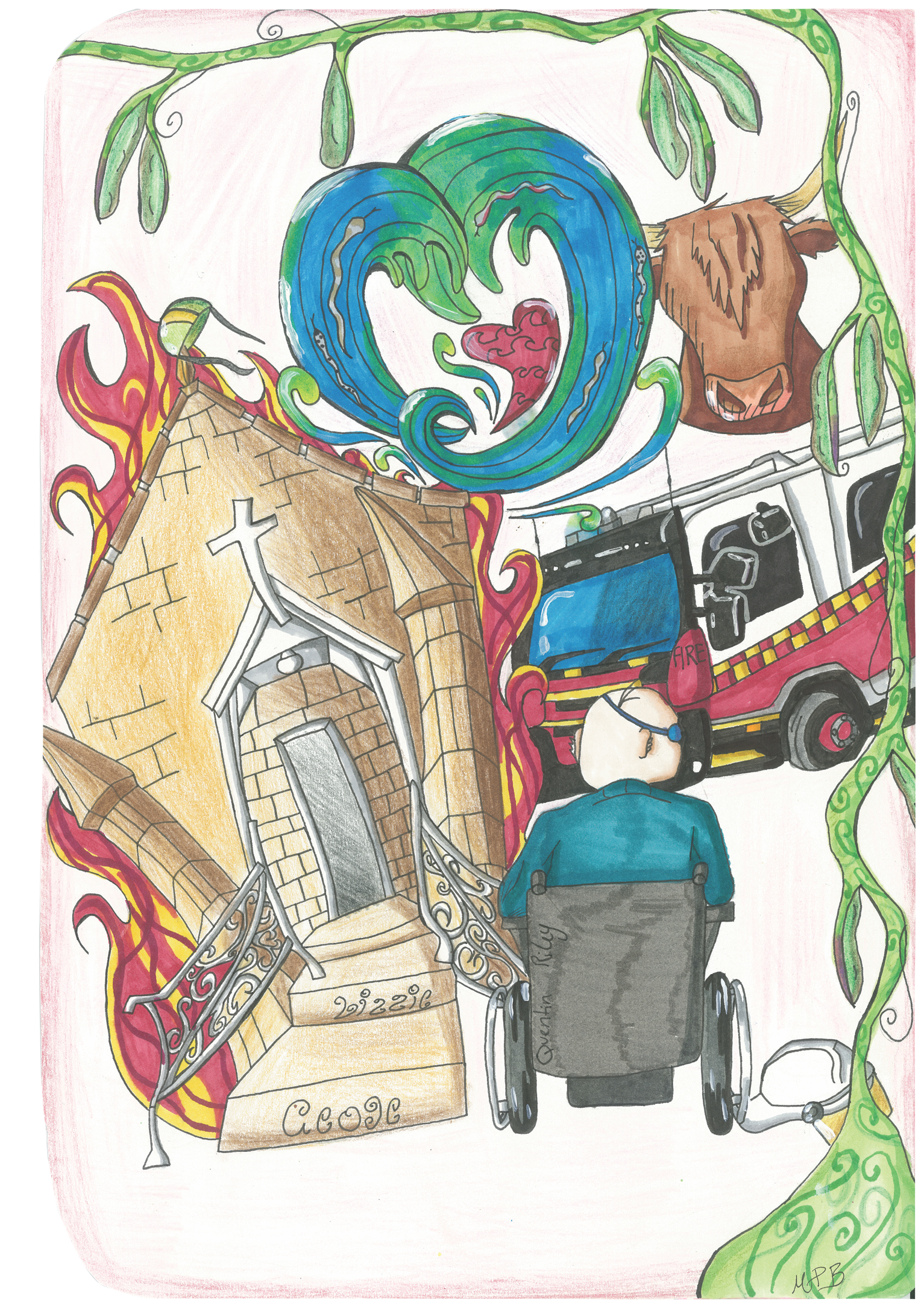
Mali Brown, 14 years old

My great-grandparents, George and Lizzie Frost, lived in Kincumber from the 1860s. They were married in Kincumber’s St Paul’s
church and lived in their original house next door – which is still standing.
In 1899 they purchased from Donald Macmaster 250 acres of farmland, the area which is now known as Copacabana.
The farm was used to graze cattle. Bullocks were used to clear and plough the land for bean farming, and in winter
were rested from hauling timber, which was used at the Frost’s sawmill at Kincumber. My father, Clarrie, had vivid
recollections of going with his uncles — the Frost boys — to Copacabana to collect the bullocks.
The Copacabana area was known by residents as Tudibaring – an Aboriginal word meaning ‘where the waves pound like a beating heart’.
It was also called Judi Barn, Allagai – an Aboriginal word meaning ‘place of snakes’.
In 1954 Gosford Shire Council gave permission for Copacabana to be developed. They named the suburb after the world-famous
Copacabana Beach in Rio De Janeiro. As people started to move into the area there became the need for a surf club, and in 1967,
Copacabana’s Surf Life Saving Club was established.
My grandmother, Isabella, lived in Riley’s Bay near Woy Woy, where in 1900 my father Clarrie was born.
Familiar with the beauty of the area, in 1947 Clarrie and my mother, Beryl, moved to Avoca, where I was born in 1948. I have lived here all my life.
I have two strong memories of Copacabana. The first is being in the Rural Bushfire Brigade. Fires at Copacabana were severe,
as the terrain has some very steep sections and in summer the hot westerly winds blew up the inclines with remarkable ferocity.
We had to be careful that we did not get trapped upwind as the hot fire assisted by the hot wind could burn at a very high velocity.
We were lucky to have the comradery of our fellow fire-fighters and we all looked out for each other.
I remember driving in Copacabana with my dad and getting bogged at the time when the land was being subdivided.
The grader driver came to our rescue.
In 2015 while training a bronze medallion group, I broke my neck in the surf at Avoca Beach. Due to surgical mistakes in 2015 and 2018,
both my legs and my right arm were rendered paralysed. I am now 90% disabled and I had to terminate my Rural Fire Brigade membership.
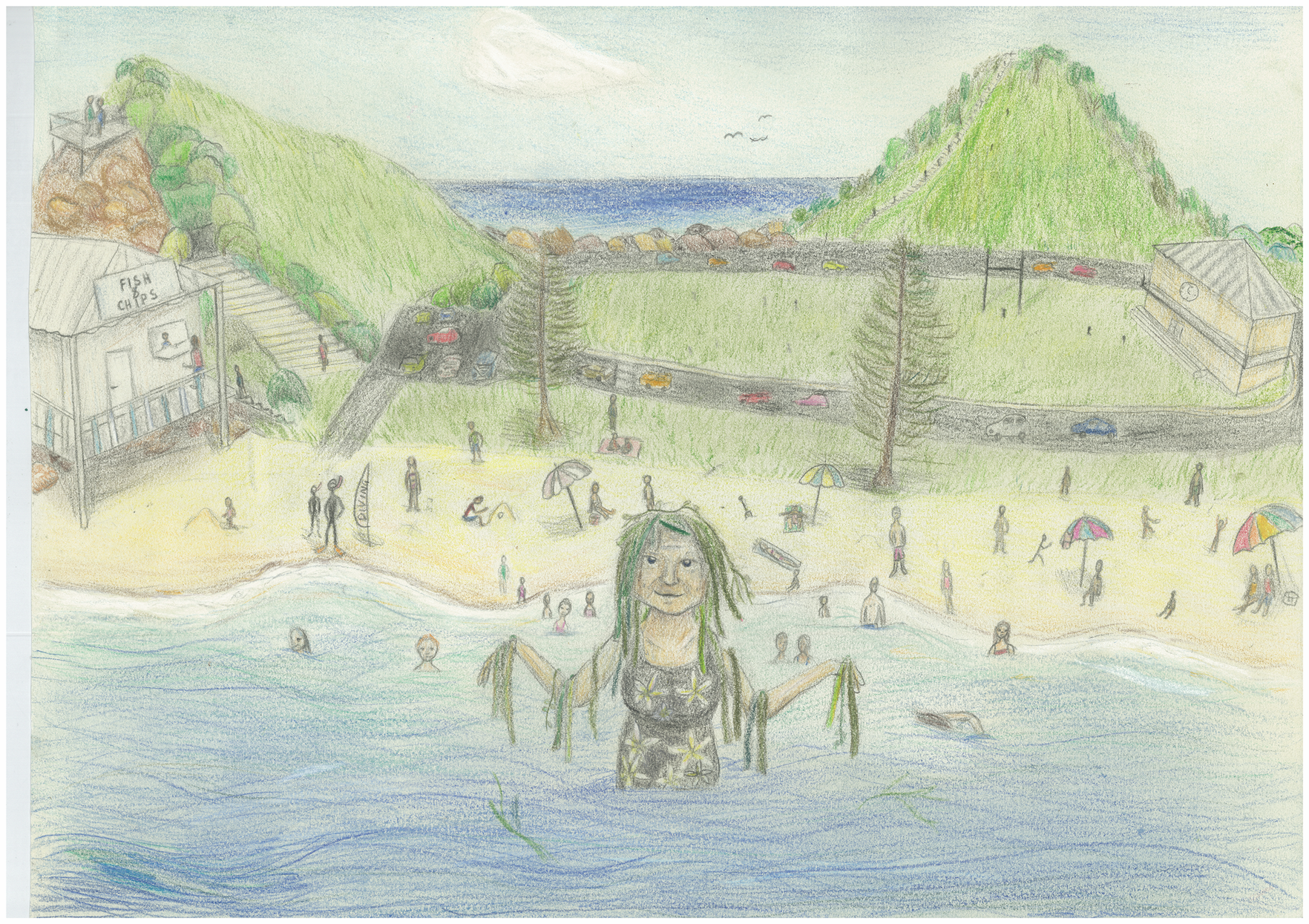
Lucy Vince, 13 years old

One Christmas break, we drove to Terrigal in New South Wales. We walked slowly up the hill,
step by step through a pocket of dense coastal scrub: lomandra lining the path, scratching our legs; the twisted limbs of banksia
reaching up festooned with morning glory creeper; lantana; and the ever present, weedy, self-sown asparagus fern, crowding and invasive.
Then out to the viewing platform, the sun and the sea.
We stood staring at that vast ocean and breathed the salty air. To the south and east all was a-glitter of ocean and sky,
almost burning our eyes. No sign of another world, a panorama infinite and grand. Below us stretched the flat slab of rock
hugging the sandstone cliffs that curved down to the south, waves washing up and over, spreading their whitewash before receding,
only to start again; the endless, mesmerising repetition.
Then we turned to the north-west and the shore, wind at our backs and we silently observed the peopled world of roads and crowded
buildings. For a brief moment we were isolated, reluctant to return, to shuffle down to join the 'madding crowd' of holiday makers,
the fishing boats, the diving school and cafes.
I was determined to swim, yet stood aghast at the mounds of fresh seaweed piled in clumps all along the beach.
Wearing my old once-abandoned swimsuit, iodine strong in my nostrils, I tiptoed to the curled edges of the waves,
all clogged with marine growth torn from the ocean floor in a turbulent tide. How to progress to the clearer water beyond?
I stood swaying, my legs captured in the slimy weed, then I tumbled down into the swirling green mass, breast-stroking the kelp aside,
seagrass threading through my fingers, trailing down my back.
No-one watched this old lady attempting to frolic in the cool clear water beyond. They were all at play: children running,
fathers digging, old people sitting, youthful bodies sunning; a scene of joyful ease.
My white limbs emerged from the weedy wash of waves like some prehistoric creature. I had to laugh, and waved at my husband
sitting on his bench, but he could not see.
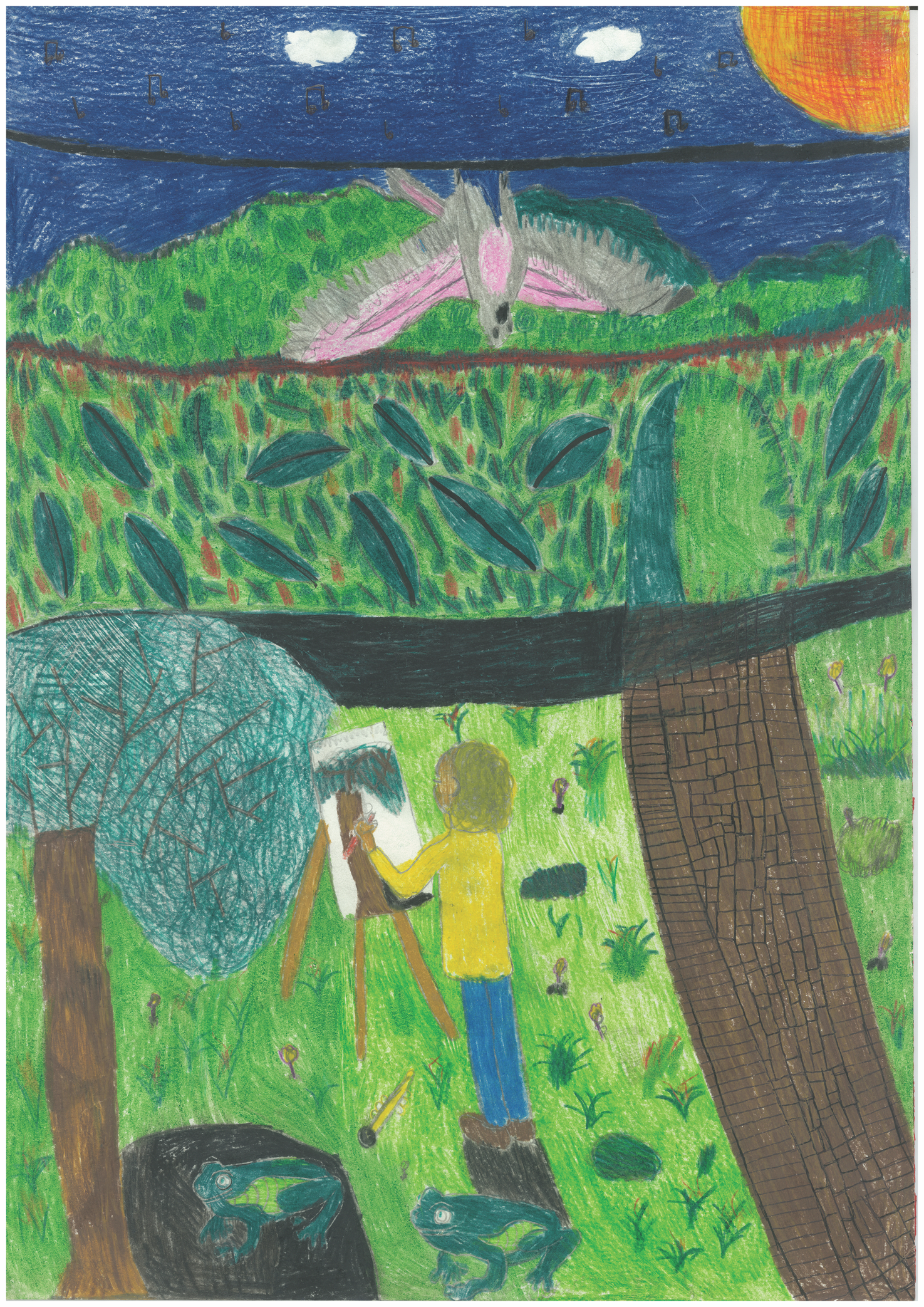
Jacob Barrington, 11 years old

Seventeen years ago, we made the decision to live on the Central Coast; my husband’s health was declining,
and we were looking at retirement villages with ongoing support and care. After investigating villages all
around Sydney, we returned to Brentwood, Kincumber. We liked its garden setting, the walkways and lake,
and its friendly atmosphere.
From my kitchen window I can watch galahs somersaulting on the power lines. Sulphur-crested cockatoos
squark in the morning, and magpies and kookaburras defend their territory, along with doves and many other
birds. A sarus crane visited my front garden, no doubt looking for a frog, skink or water-dragon to eat.
Not only do I live in a picturesque environment, close to beaches and national parks, the creative community of the
central coast — so varied — has lasting surprises! The hills are alive with music for all tastes: classical renditions
from the Symphony Orchestra Concert Band, as well as choirs and other ensembles; jazz and pop music are well represented.
There are live shows and theatre, as well as reading and discussion groups.
As a practicing artist since my mid-life crisis, I admire Gosford Regional Gallery with its exhibitions, art classes,
workshops and numerous art societies.
Soon after our arrival I was able to join the 5 Lands Walk and visiting the artist’s studios. In this
amazing landscape we watch the ocean’s changing pattern, tides advancing and receding; light and shadow on
sand and cliffs; migrating whales and confident surfers, in cosseting breezes and howling thunderstorms.
People visiting beaches exude a sense of happiness, and this holiday spirit creates a lasting mood which makes the
difficulties of adjustment and medical problems pale. The Central Coast is beautiful and creative — a jewel!
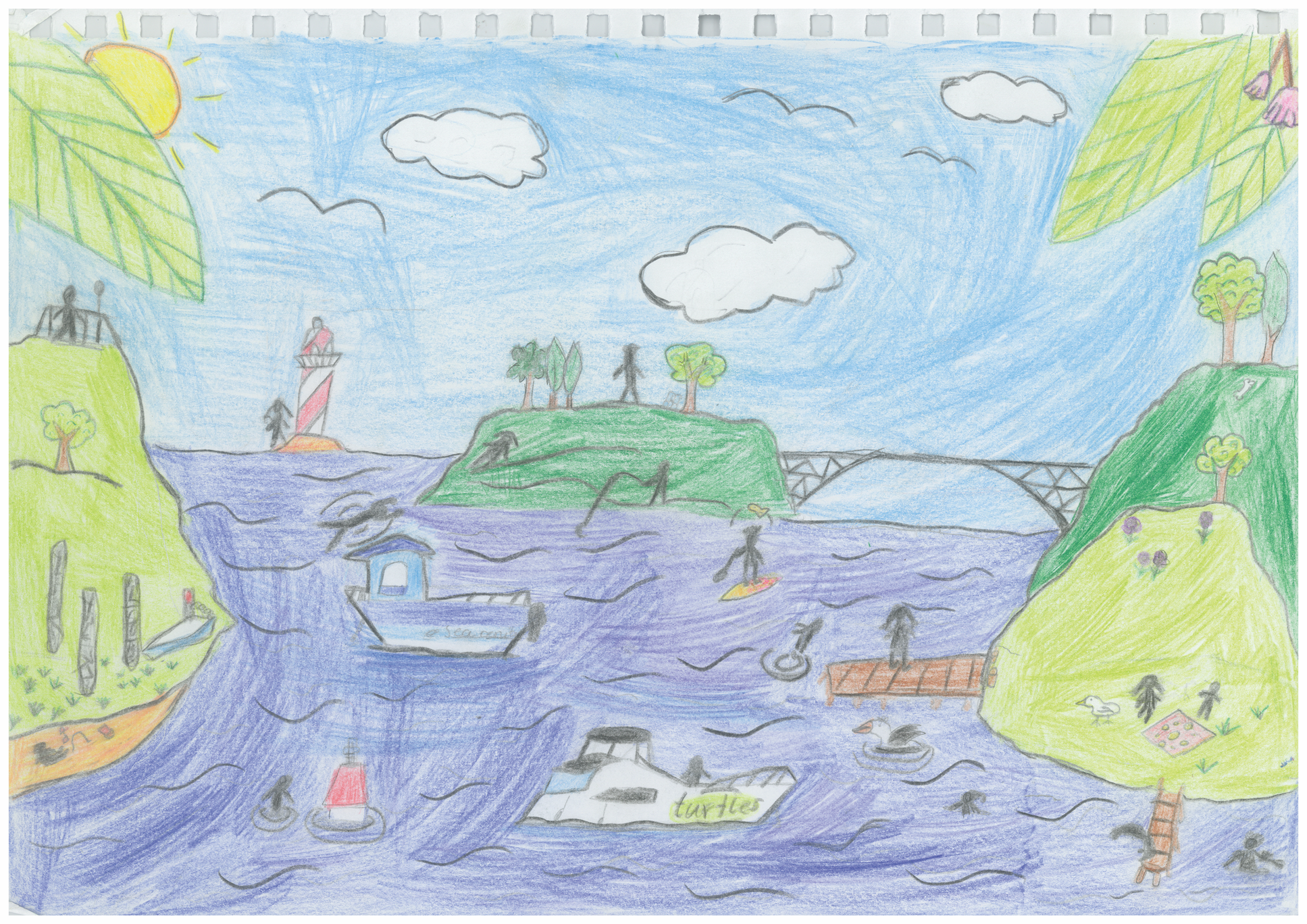
Neve Bellingham, 9 years old

My wife and I lived at Cromer on the Northern Beaches and one sunny Sunday we decided to go for a drive.
Terrigal was our destination, where we had lunch.
On our way back I made a wrong turn and we found ourselves heading to Killcare. This was new territory for us. We approached Hardys
Bay down Killcare Road, and as we turned the bend the view facing us was a ‘wow’ experience: a clear blue sky over the sparkling
water reaching past the Rip Bridge. It was spectacular.
We decided we had to live here, so we went to the real estate office and settled on an old house in Heath Road.
It was rundown, in need of some TLC and a renovation. We lived rough for a year and then enjoyed the refreshed house,
overlooking the water to Ettalong and Wagstaffe.
The Marie Byles Lookout is on the southern fringe of the 5 Lands area and is the best viewpoint on the Coast.
The birds-eye view of the ocean and inland waterways of Pittwater, Lion Island, Barrenjoey Lighthouse and
Westhead is breathtaking. There is a tranquil serenity that stirs the emotions. The best time to experience the
lookout is on a clear, sunny day at any time of the year, with the fragrance of native flowers and the smell of
the sea carried by gentle breezes.
The view is best seen with a loved one. On occasion the peace is shattered by the arrival of other vehicles.
I don’t regret my selfish attitude, but who could deny other visitors this ambience of magnificent coastal views and Bouddi National Park?
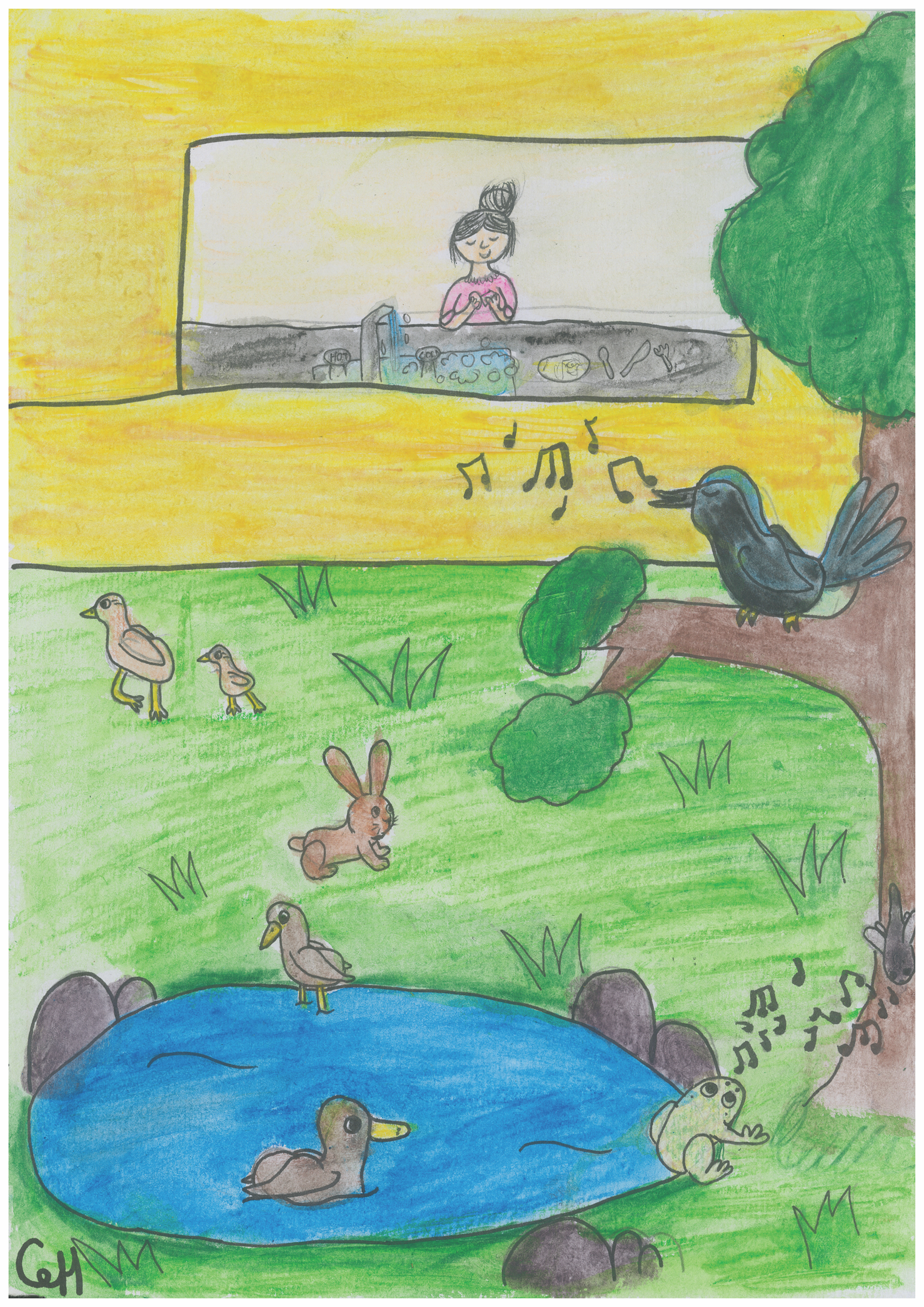
Chloe Holland, 10 years old
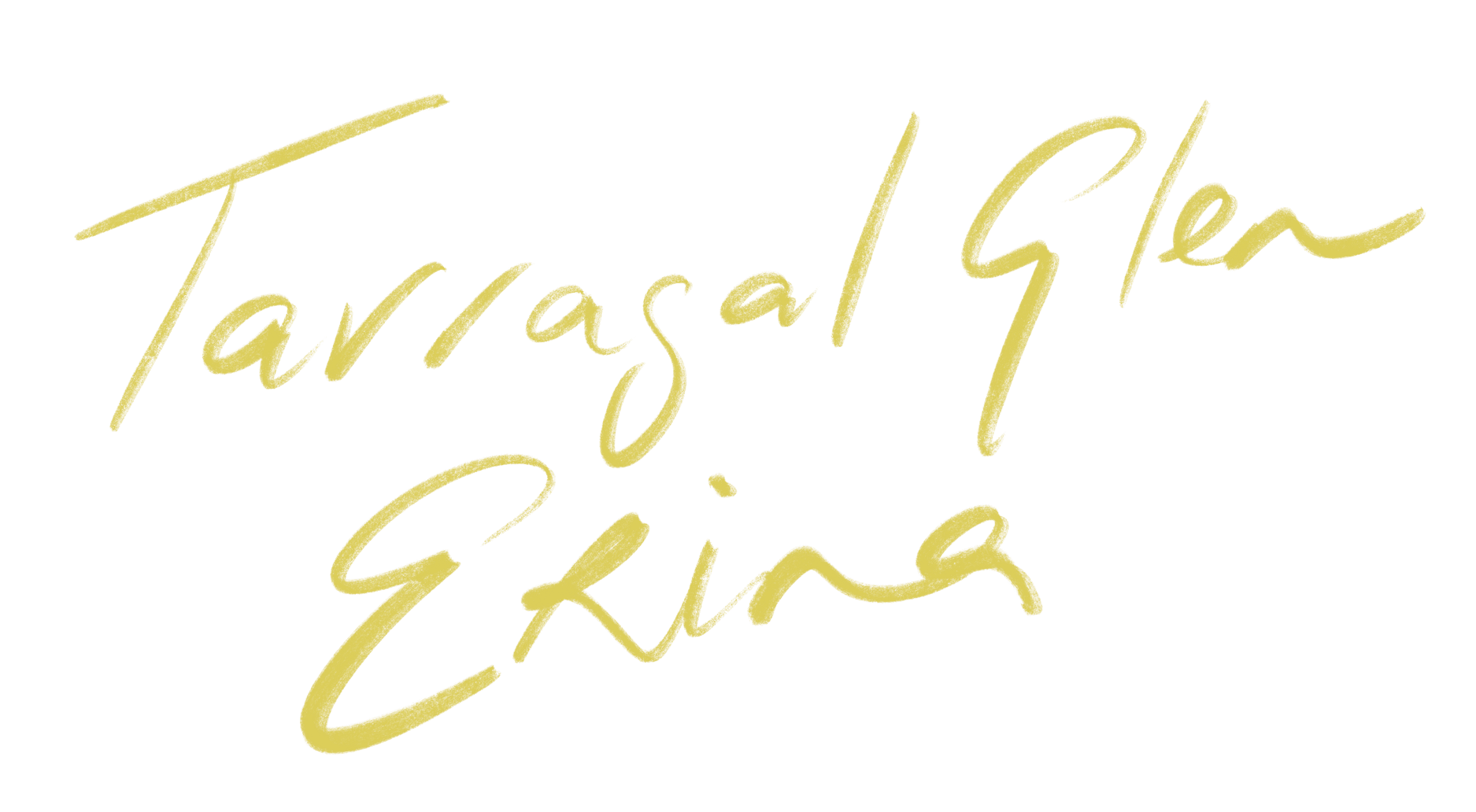
I had reached retirement age and it was time to move out of busy Sydney.
Now I live in Tarragal Glen Retirement Village, and I’m fortunate to have a beautiful park outside my
back door. There are always sights and sounds of birds, ducks on the pond, waterhens and rabbits.
This morning I looked out my kitchen window and there was a baby plover with her mother waking by.
The area at night is a cacophony of nature, particularly as we draw near to Christmas.
There are bush frogs and cicadas trying to outdo each other!
The people in the village are particularly friendly, and because I walk my dog twice a day I meet
quite a few people along the way. The neighbours close by often get together for a cuppa or a glass of wine.
Moving to Erina seven years ago has definitely been a transition, and happy one at that. It was the right move.
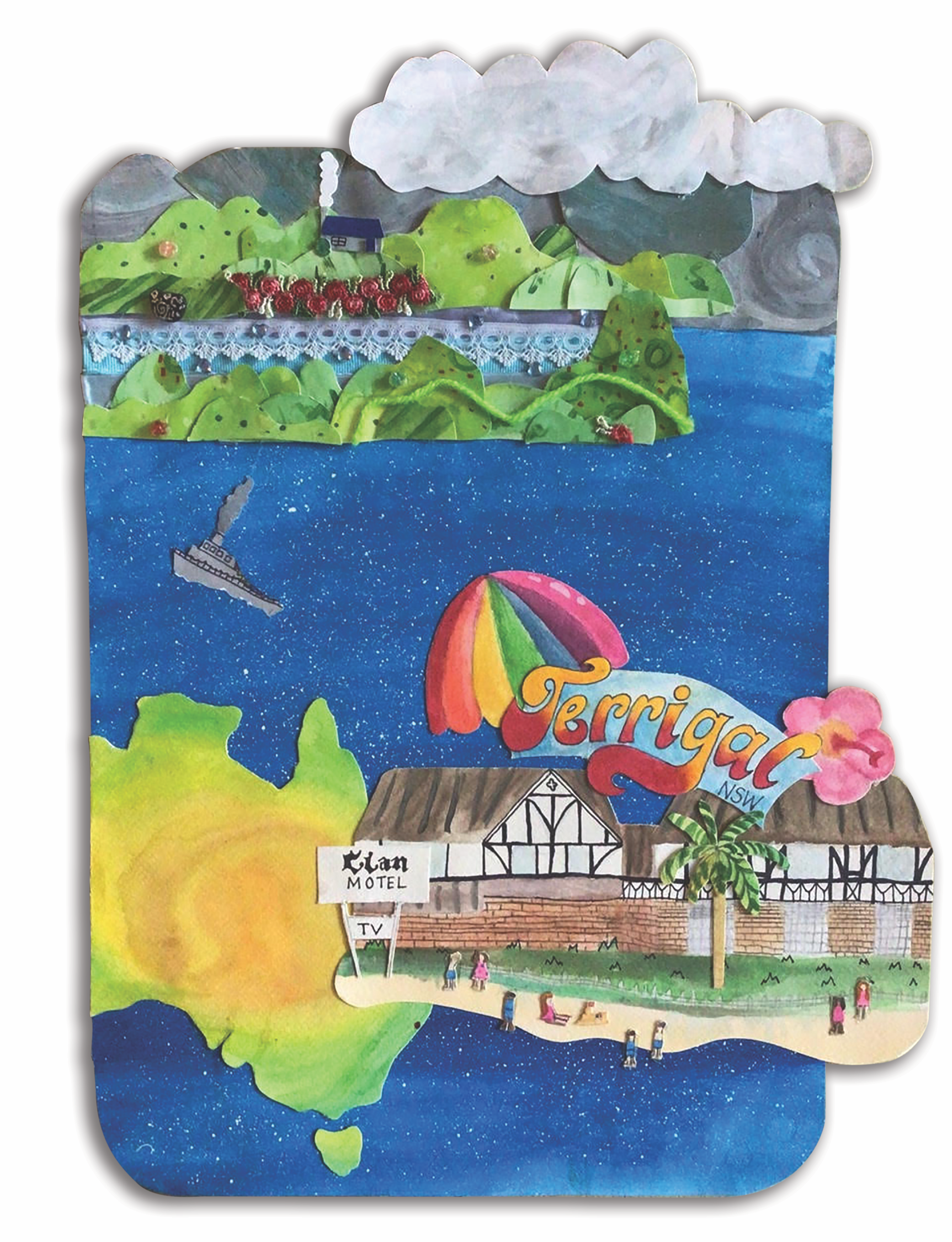
Kaia Helle, 11 years old
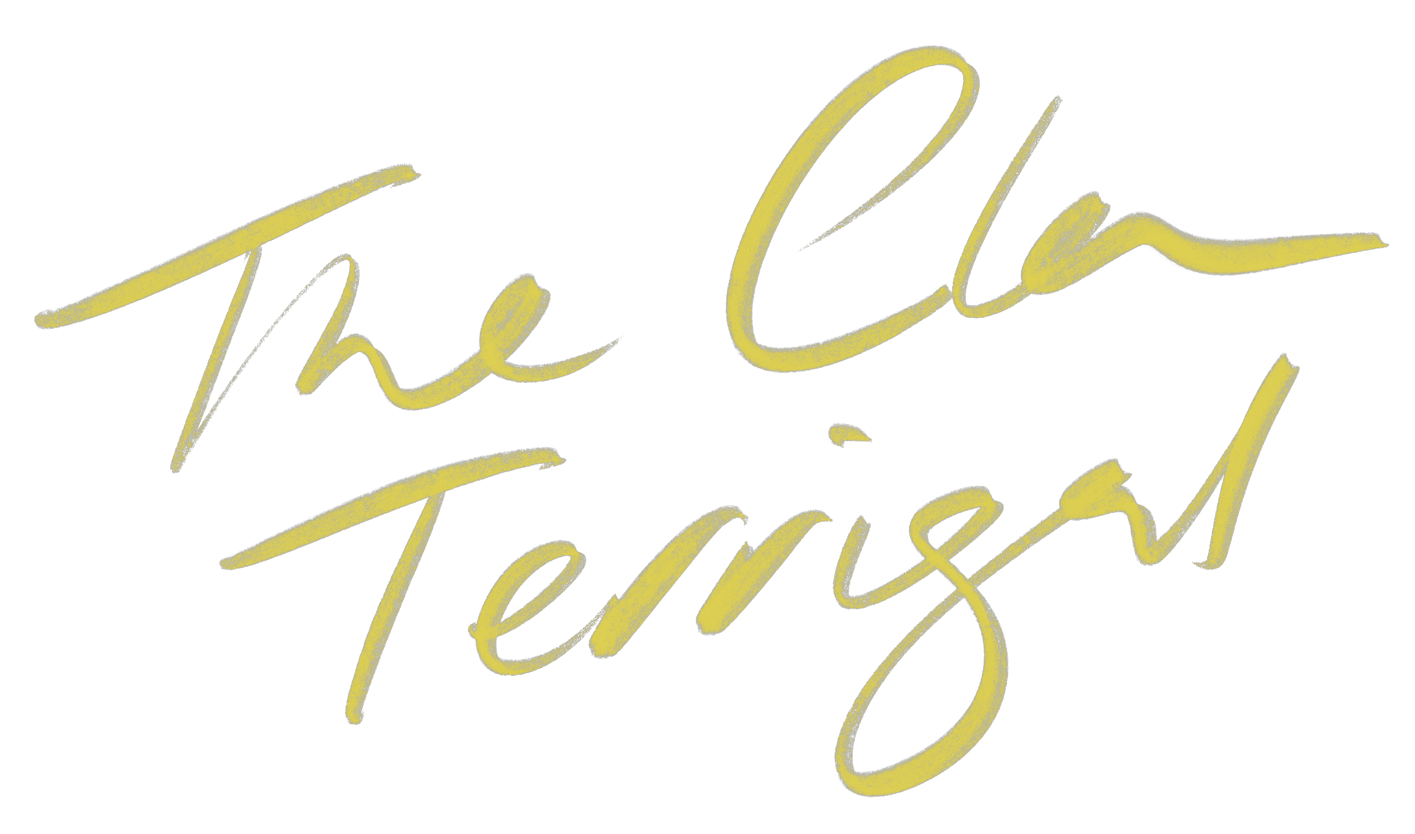
Everyone loves the place where they were born or grew up, a place where they were happy.
I remember my home in Scotland when I was a young married woman; we lived on 3 acres in the hills in Hardgate,
looking down the long Clyde River Valley, the river glinting like a silver snake in the distance on its journey
to the sea. Deer ran in the hills above us. We had built our beautiful home ourselves, as my husband was a builder.
At the bottom of our land was a most unusual piece of black rock, covered with intricate carvings of symbols
from prehistory, from the time of the Druids. Professors from Glasgow University came to study and photograph
it. The Druid stone was eventually covered with soil to protect and preserve it for future study.
Despite doing well in business, we looked to the future for our children and felt it would be better to leave U.K.
It was hard to leave our beautiful place. It was a big upheaval to sell our businesses, and sad visiting each
of our families and friends to say goodbye. We had chosen Australia, which in 1966 seemed like going to Mars.
Yet our choice was correct. A few weeks after everything we had was transferred to Australia, the U.K. Government
devalued the pound sterling by 14% and that country fell into a steep decline that lasted decades.
In Australia, we found Terrigal, a wonder for our children who were used to living in the hills. They found the sea,
the beaches, surfing, fishing and the carefree life of an Australian child. My husband Patrick and I built The Clan Motel
on the shores of Terrigal Lake. We owned it for 20 years. There we worked hard while our children played in the sea and lake nearby.
We made friends and came to love this new place in our lives. Every time I drove into Terrigal, a strange feeling came to me,
a sensation of peace and happiness. I had found a new sense of place.
I admire Dorothea McKellar’s Sunburned Country; we see our land through her eyes and fall in love with it.
This country is a land of stark contrasts, each of them beautiful. It boasts a people I am proud to belong to,
who volunteer in the surf, in our hospitals and against the terrible fires which have ravaged our country;
good people who help one another. As well as its beauty, a sense of place includes the people who inhabit it.
Australia is my place.
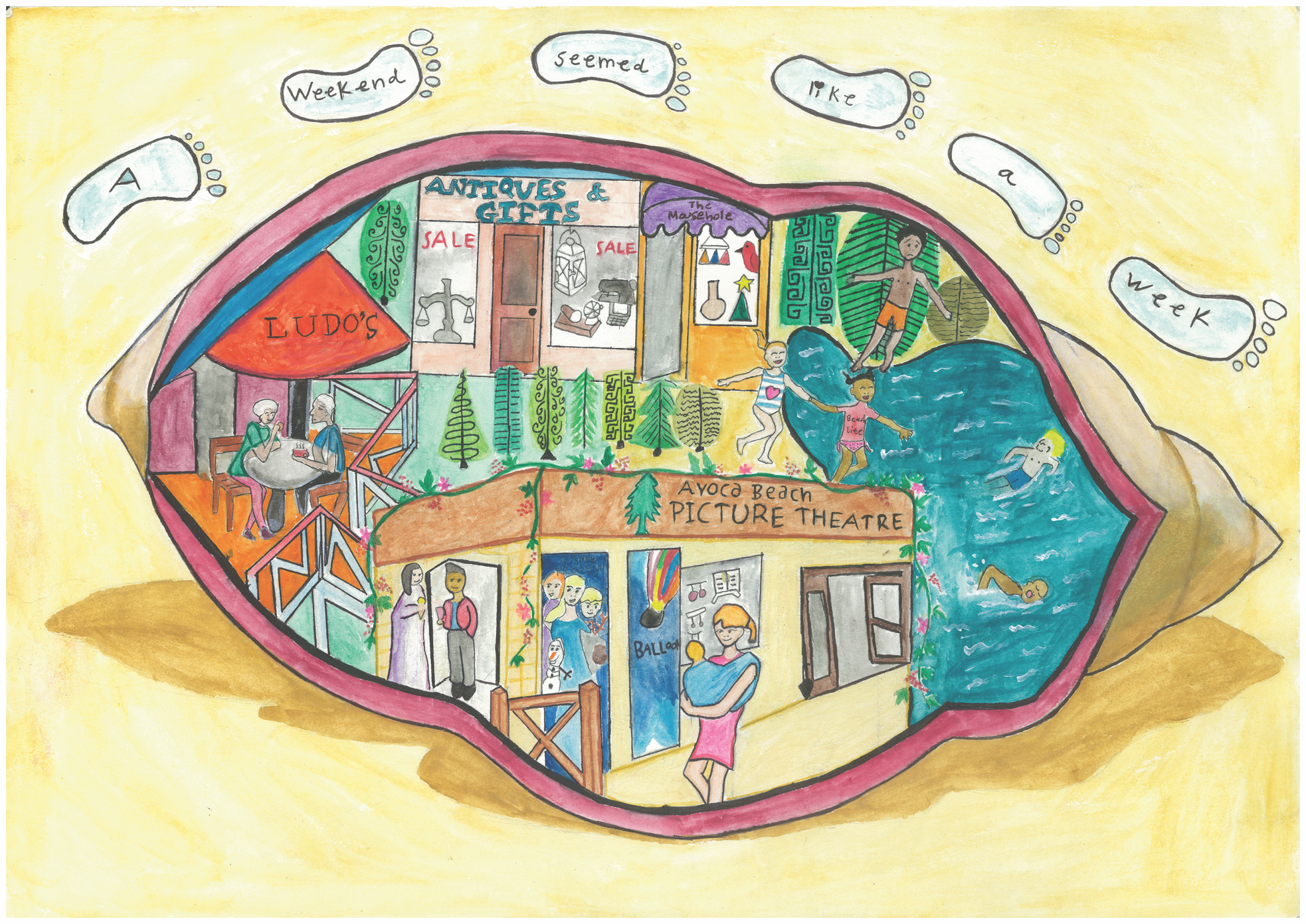
Ga Ga Gribble, 18 years old
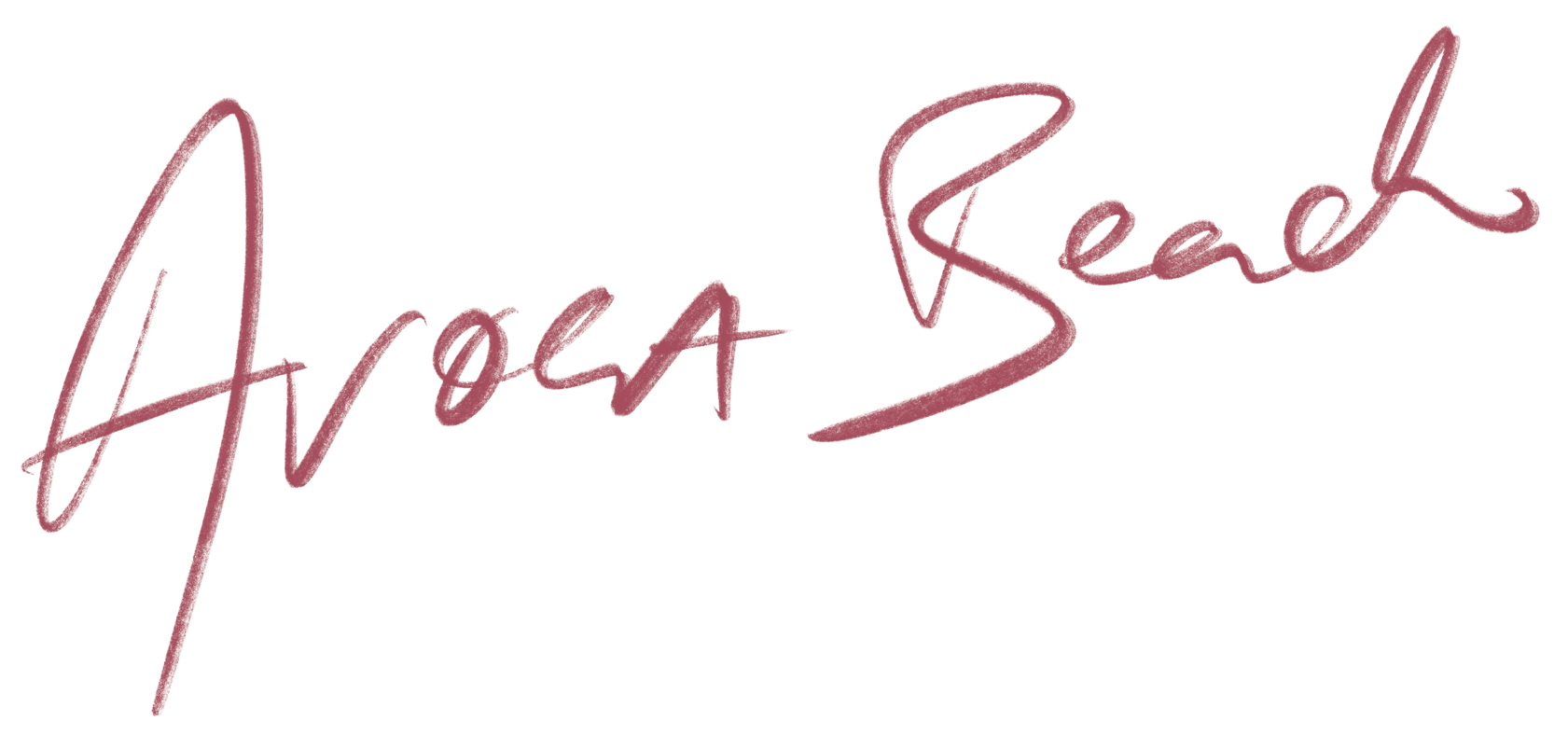
Our love of the Central Coast began long before we came to live here, twenty-nine years ago. We often stayed with
friends and family in their holiday cottage, right near the beach at Avoca. We came at least monthly with our friends of sixty years.
It was so relaxing, a weekend seemed like a week. We would call in at the baker (now called Ludo’s) early for fresh rolls,
and the smell of fresh baked bread was divine. We’d sit on the verandah with a coffee and we’d people-watch;
wander over to the lake to see what activities were going on; stroll along the beach. We delighted in watching
children trying out the water with their toes, some eager, some tentative. We would check out our favorite shops,
the Antique shop and the Mouse Hole, both full of treasures so different from each other. If it was raining,
though that wasn’t often, we would go along to the lovely old cinema. We rarely explored elsewhere, though
once we visited the Lavender Patch, sadly no longer around.
We never had any thoughts of living here, but one Saturday morning we were looking in the real estate window in
Kincumber (now the optician). We saw a house that looked interesting and thought we’d have a look after lunch for something different to do.
When we pulled up outside the house, I was almost hyperventilating it was so beautiful. Once inside, we were completely in love.
We made an offer, it was accepted, and we raced home to sell out house on the Northern Beaches.
We had to do a lot of exploring when we came to live in Kincumber. I’d never even been to Erina Fair. We have been at Brentwood Village
for seven years now, and it was an easy transition as we were locals and had a life outside the village.
Avoca was the very beginning of the best decision we have ever made.
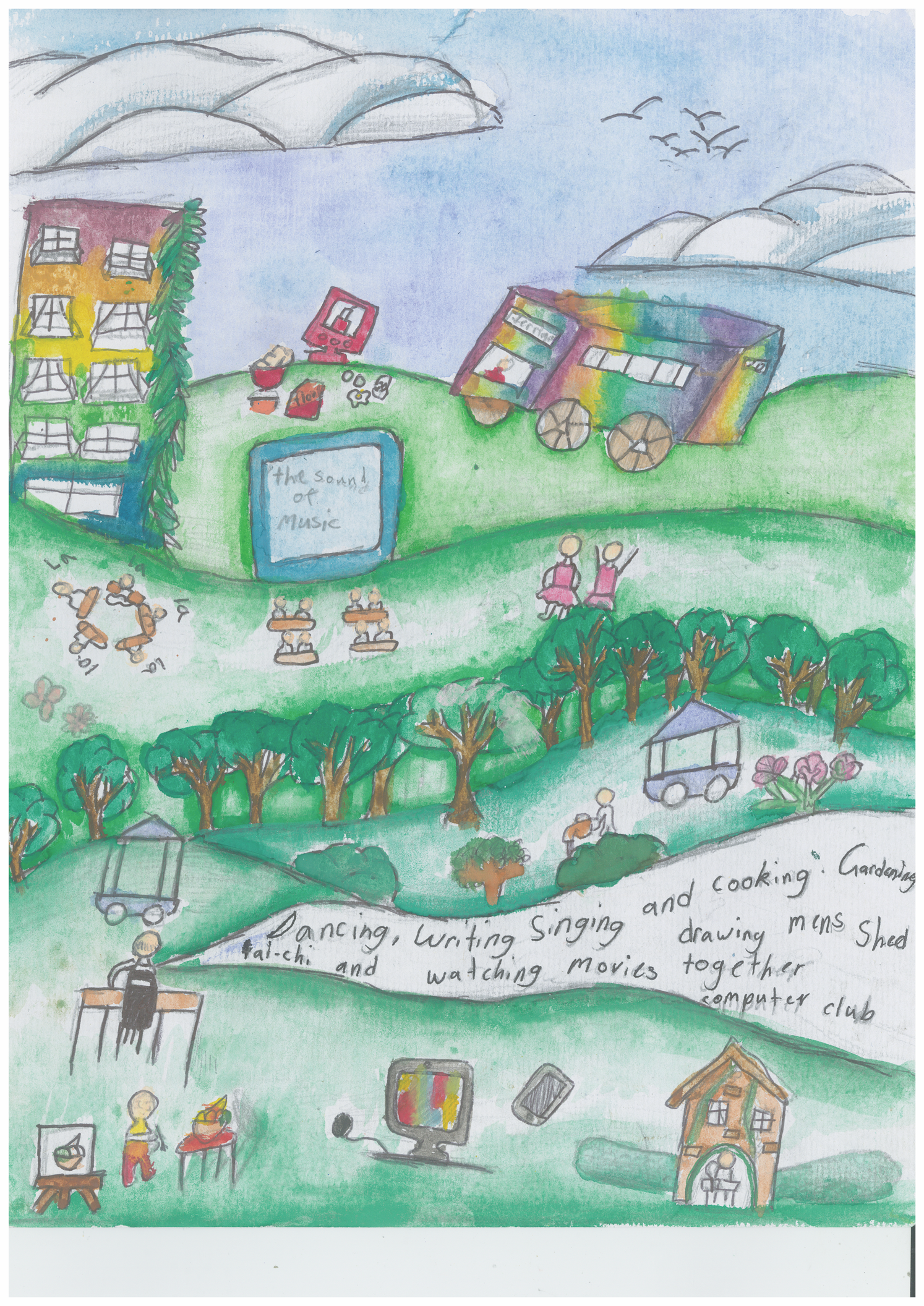
Poppy Dheer, 11 years old
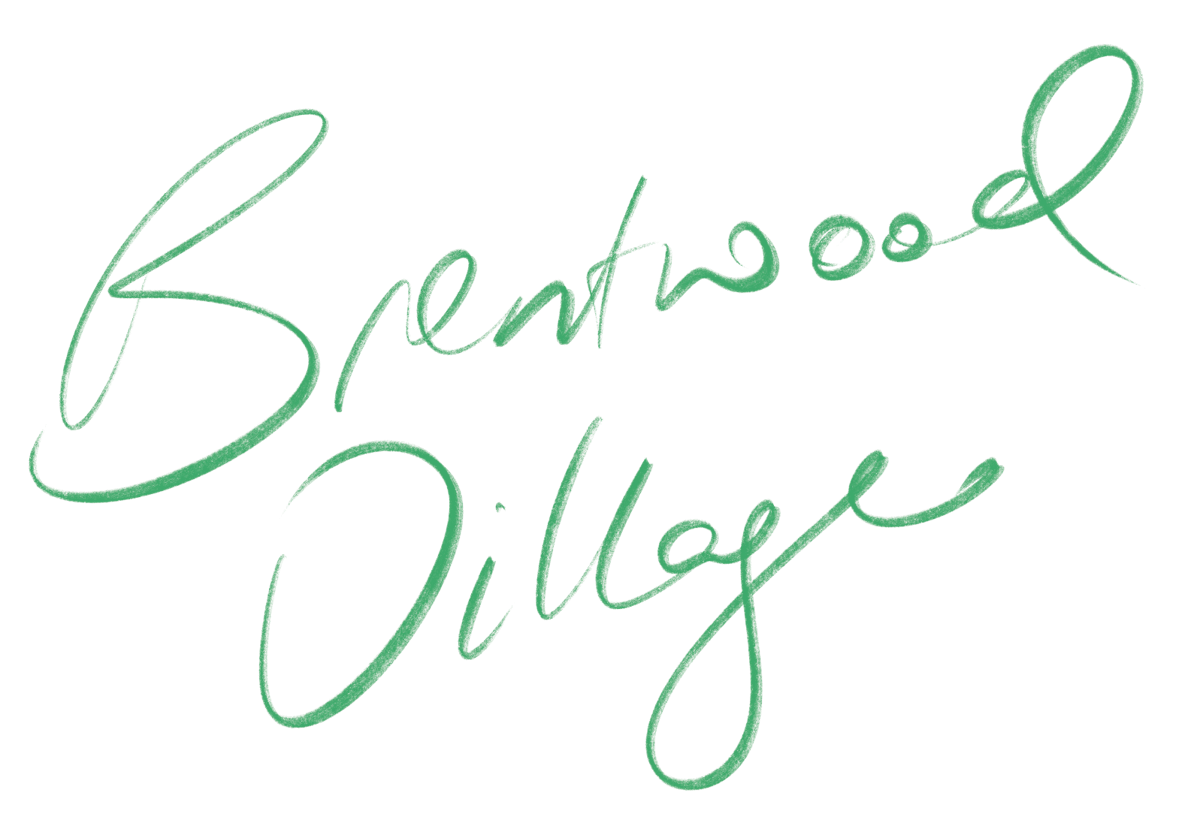
Brentwood Village with its floral surrounds,
Is a great place to live where much beauty abounds.
The lake, the shrubs, the trees and flowers,
A lover of flora may gaze here for hours. But Brentwood is more than a beautiful place,
It’s a haven for sharing and living with grace.
No rush or bustle disturb the days,
And village life enriches in so many ways. Activities there are to suit any taste,
One can do many things without pressure or haste.
Classes are held for bending and stretching,
Line dancing and bowling, Thai Chi and swimming. You may play table tennis or go to the gym,
All these may suit, if you wish to stay slim.
It’s not just the body Brentwood keeps trim and taut,
There is much for the brain that can also be taught. One can learn to play bridge, Mah-jong and Euchre,
Use smart phones, tablets, join a club for computers.
There is a choir for singers, Probus for thinkers,
A library for readers, a tavern for drinkers. Movies, concerts and trivia nights are fun
Thoughtfully arranged to entertain one,
Join the poets and writers, meet for lively Ted Talks,
If this doesn’t suit simply go for some walks. If you don’t wish to walk, there’s no need to fuss,
You can ride in a buggy or in Brentwood’s bus.
Go shopping or sight-seeing or a trip to the beach,
This bus and the drivers have a generous reach. There’s a Men’s Shed, and snooker, bingo and darts,
Volunteers and workers play a large part.
The Brag committee give selflessly as we can see,
When the Brentwood Times is produced and delivered free! With all this activity, too much to name,
Life is busy and varied, never the same.
All residents who live in a place so good,
Should give thanks to the founders of this Brentwood.
Is a great place to live where much beauty abounds.
The lake, the shrubs, the trees and flowers,
A lover of flora may gaze here for hours. But Brentwood is more than a beautiful place,
It’s a haven for sharing and living with grace.
No rush or bustle disturb the days,
And village life enriches in so many ways. Activities there are to suit any taste,
One can do many things without pressure or haste.
Classes are held for bending and stretching,
Line dancing and bowling, Thai Chi and swimming. You may play table tennis or go to the gym,
All these may suit, if you wish to stay slim.
It’s not just the body Brentwood keeps trim and taut,
There is much for the brain that can also be taught. One can learn to play bridge, Mah-jong and Euchre,
Use smart phones, tablets, join a club for computers.
There is a choir for singers, Probus for thinkers,
A library for readers, a tavern for drinkers. Movies, concerts and trivia nights are fun
Thoughtfully arranged to entertain one,
Join the poets and writers, meet for lively Ted Talks,
If this doesn’t suit simply go for some walks. If you don’t wish to walk, there’s no need to fuss,
You can ride in a buggy or in Brentwood’s bus.
Go shopping or sight-seeing or a trip to the beach,
This bus and the drivers have a generous reach. There’s a Men’s Shed, and snooker, bingo and darts,
Volunteers and workers play a large part.
The Brag committee give selflessly as we can see,
When the Brentwood Times is produced and delivered free! With all this activity, too much to name,
Life is busy and varied, never the same.
All residents who live in a place so good,
Should give thanks to the founders of this Brentwood.
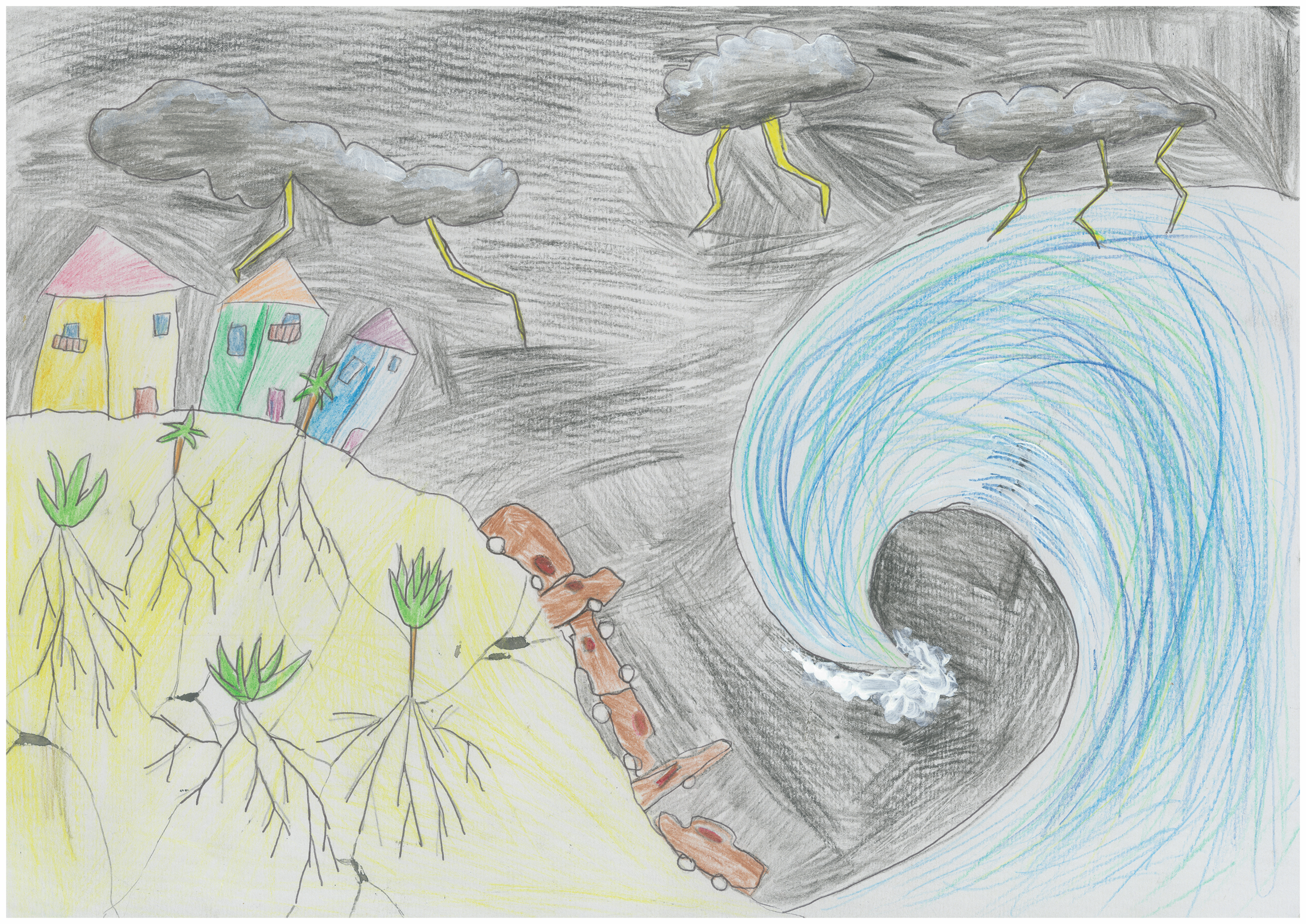
Ruby Costigan, 9 years old
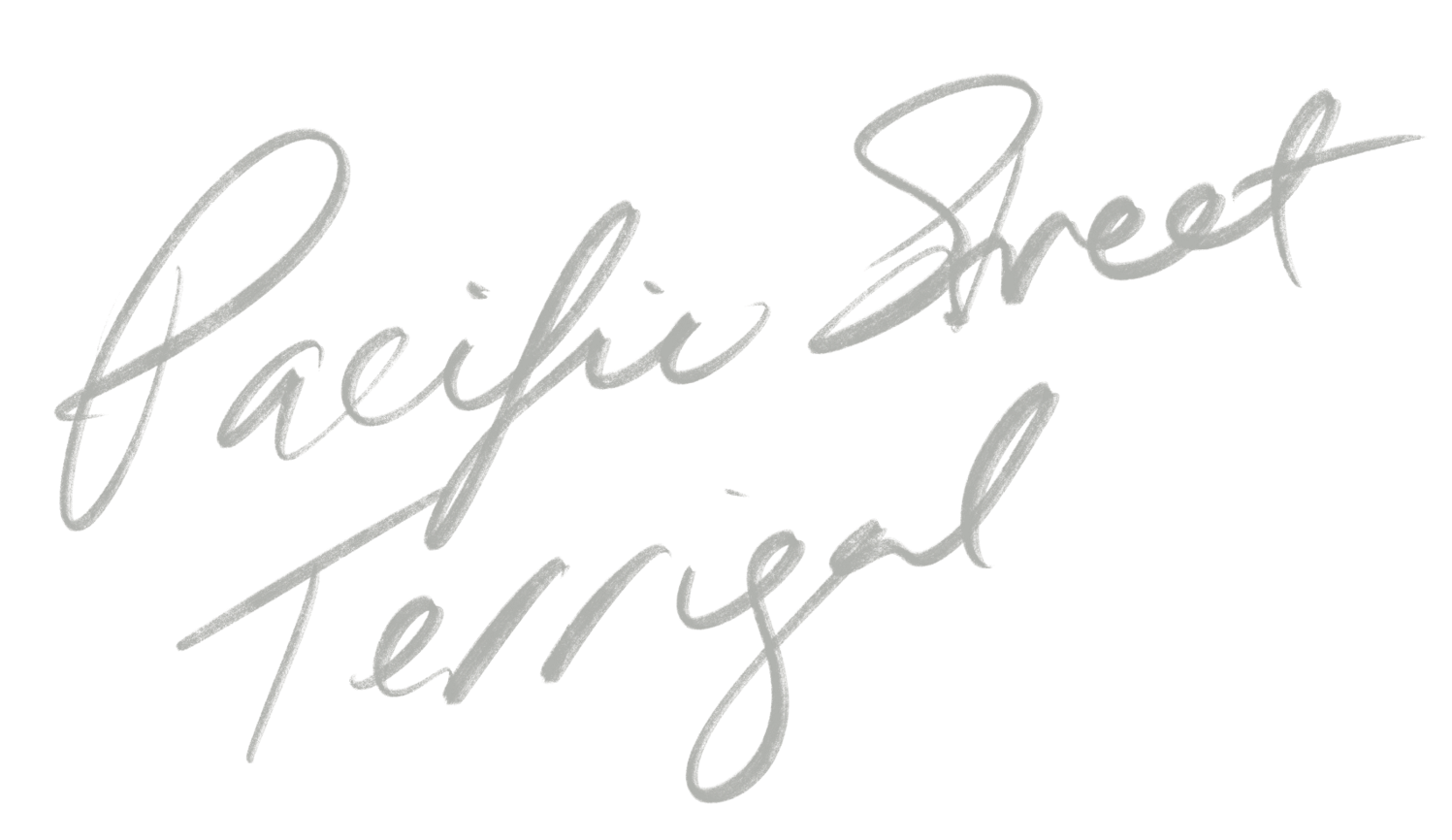
In the early 70’s, my husband and I purchased a place on the ocean side of Pacific Street in Terrigal. Its previous owner was a
geologist, and he told us how storms and tides regularly moved sand from the dunes out into the bay and back again. All along the boundary
of the property’s foreshore he had planted yukkas, because of their amazing root structure.
A few years later, when a big storm hit the bay and people were craning in old cars, huge rocks and chunks of concrete in
an effort to save their properties from the sea, the yukkas “held the fort”, with a three meter sheer drop revealing their root structure.
Sure enough, after a couple of years the dunes were back, vegetation returned, and things were as nature intended —
except for the giant boulders and loose sand next door. No doubt the big storms and king tides have long since tumbled them out into the bay.
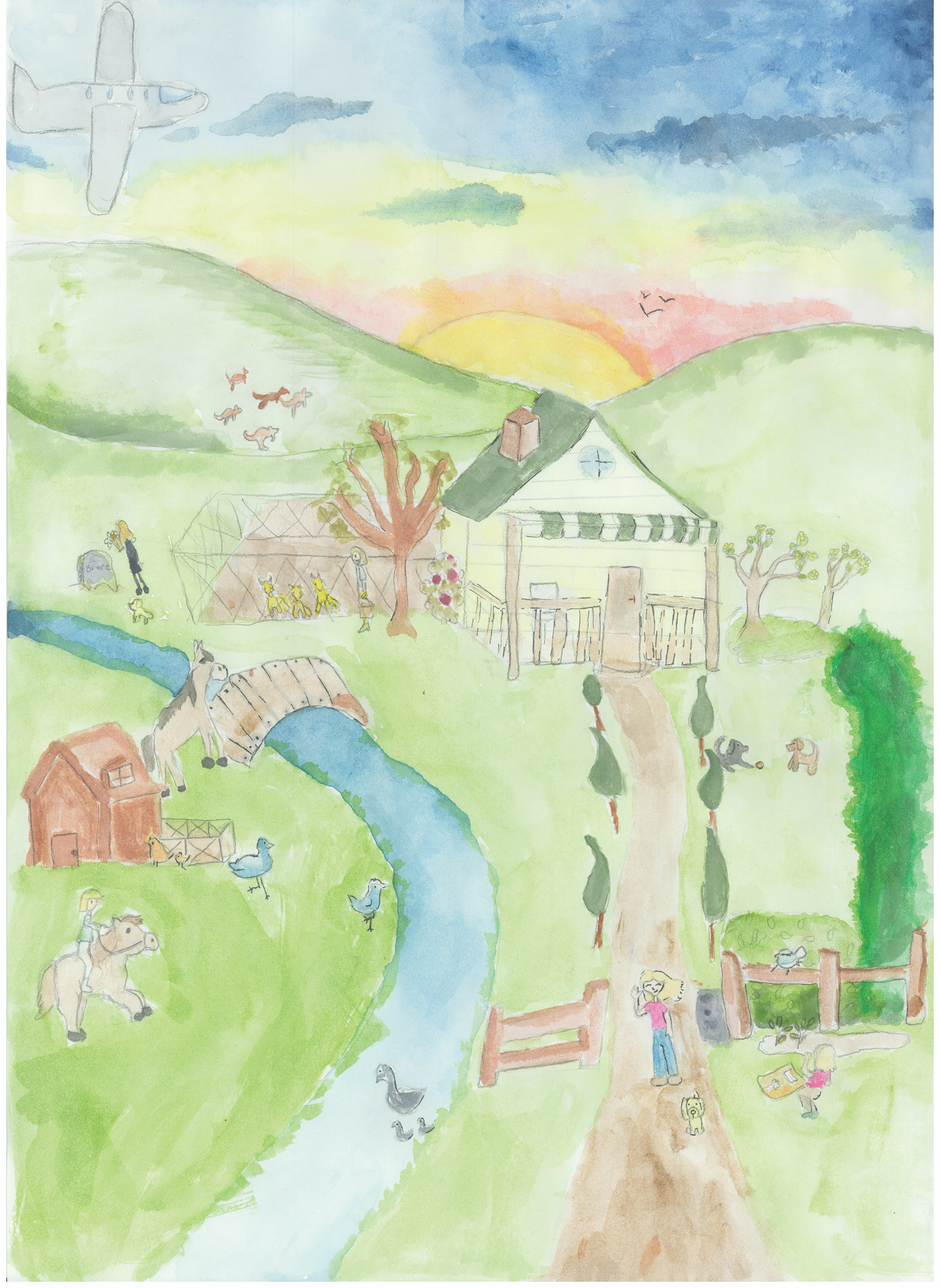
Zoe & Ava Perak, 11 years old

I found my ‘patch of paradise’ while visiting the Central Coast thirty years ago. I had not long arrived in Australia
from the UK when my husband and I discovered this beautiful property nestled at the bottom of Matcham valley,
with Erina Creek flowing through it. With its green paddocks and white fences, the valley was reminiscent of
the English countryside, and I immediately felt at home.
Although the property was run down and neglected, and the land overgrown with a variety of weeds such as
privet and lantana, and the old weatherboard cottage dilapidated, I fell in love with the place on the spot.
It was a hidden gem, just waiting for its real beauty to be revealed. Somewhere in there, was Sleeping Beauty waiting to be awakened!
It has been a long and rewarding, sometimes difficult journey to reveal the paradise that I call home. It is my whole
life and I appreciate it every day. Over ten years, my husband renovated a virtually uninhabitable shell of a house
into a beautiful, quirky cottage. It may be old, but it has character and charm.
Meanwhile, I worked on the land and over 30 years have created a lovely garden, full of colour and interest. Now in my 70s,
I am alone, as my husband sadly died a few years ago, the garden and my animals have become my joy and delight.
I revel in the beauty: the colour, the scents and the sounds. I love it that the land attracts wildlife, such as
wallabies, water dragons, moorhens and ducks. I watch all the birds busy about their lives in the garden. My special
favourites are the dainty blue wrens, darting whip birds, colourful spinebills, noisy cat birds and friendly wagtails.
My abiding love of animals had finally found a suitable home when we came here. I have always had dogs, and I used to
ride other peoples’ horses, but finally I had room to have my own. Over the years I have had horses, ponies, donkeys,
dogs, goats, geese, chooks, galahs and cockatiels.
At the moment, I have three dogs, three donkeys, two pygmy goats, two galahs and five chooks. These are my family
and I love caring for them all. I’ve had many adventures with these animals, some great fun, others more worrying!
Recently, for instance, I nearly lost my golden retriever to rat poison, while I had to rescue my donkeys from a flooding creek.
They certainly keep me active!
All the animals who have died are buried on the property. My husband’s ashes are also buried here,
on the place he loved so much, which we built together. This is not just a piece of land, or a house, it is where my heart lies.
My ‘patch of paradise’ means everything to me: my past, my present and, hopefully, my future.
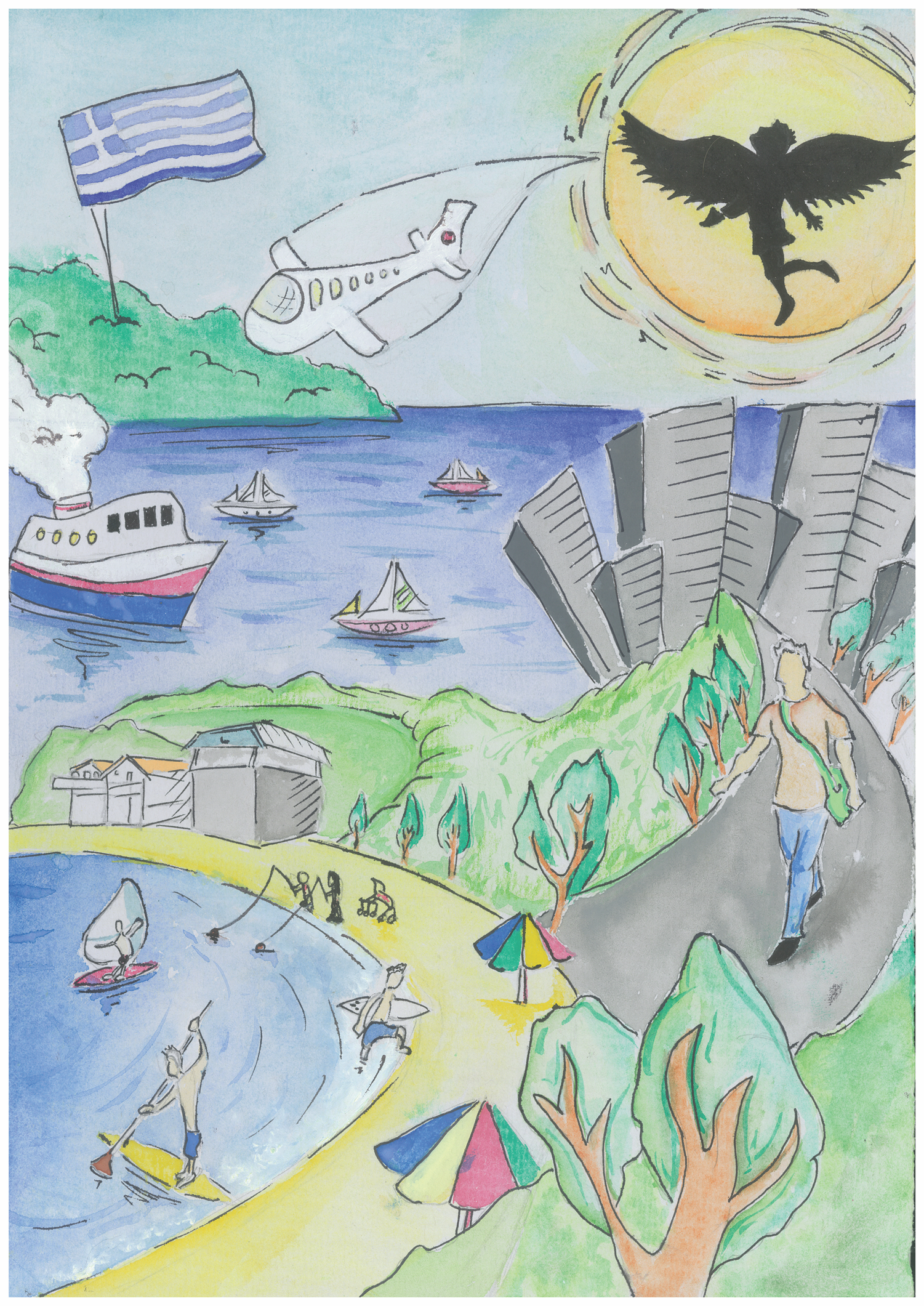
Ben Francis, 19 years old

In 1929 my grandfather came to Australia from a small island in Greece called Ikaria. There is a myth about Ikaros,
the boy who flew too close to the sun when he was escaping from a Minotaur. The beeswax in his wings melted and he
fell into the ocean, his body turning into the island that we are from.
My grandfather arrived in Adelaide by boat and walked for seven years, with a swag on his back, until he purchased a
piece of land in the New England Tablelands. When the war ended, he brought his wife and children out from Greece,
one by one, to settle in Rocky River. My sisters and I were much luckier and came to Australia by plane,
which back then took seven days.
We settled In Paddington in Sydney, but would often visit our grandparents in Rocky River, always stopping at the
Entrance to fish along the way. Something about the Central Coast reminded my father of his small island home.
When I got married in the early 70’s my husband and I bought some land in Terrigal. We had a dream of building a holiday
home with an artist retreat that overlooked the water, a chance to escape from the busyness of Sydney. Sadly,
due to the corrupt practices of realtors at the time, it was not to be. But our love for the Coast continued,
and we would bring our children to Terrigal beach for holidays as often as we could. We always dreamt of retiring on the Central Coast.
That dream became a reality when my daughter, Joanna, moved to Terrigal with her family. And to my delight she opened an art studio here,
just like her late father had done in Paddington. I soon followed, as did my parents, my brother and his family, and my other daughter and
granddaughter. Now I am with my beautiful family on the beautiful Central Coast.
When my grandchildren were young, I would take them fishing at the Entrance. Their great-grandfather would sit in
his walker watching, remembering when he would bring us here to do the same. Wonderful memories fill this wonderful place.
